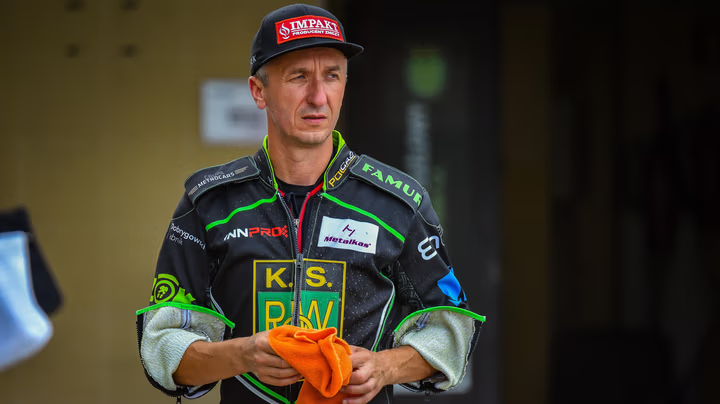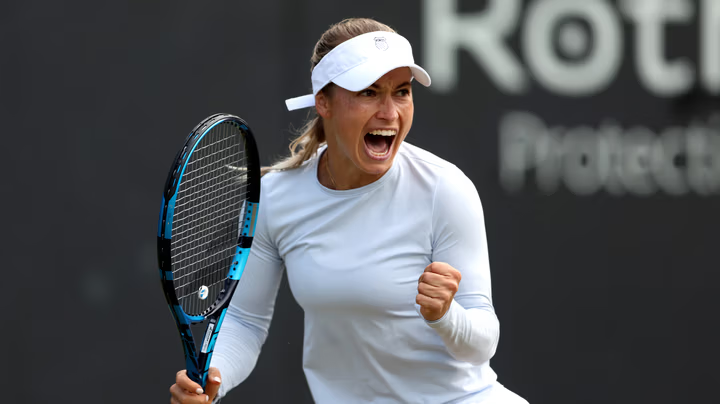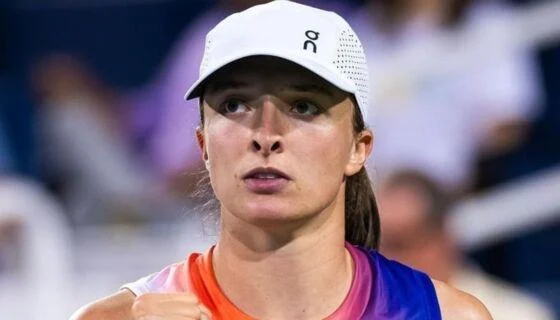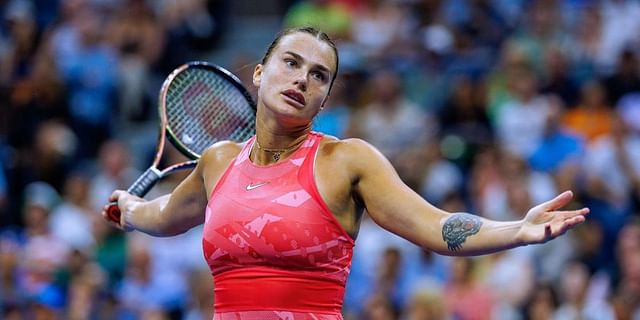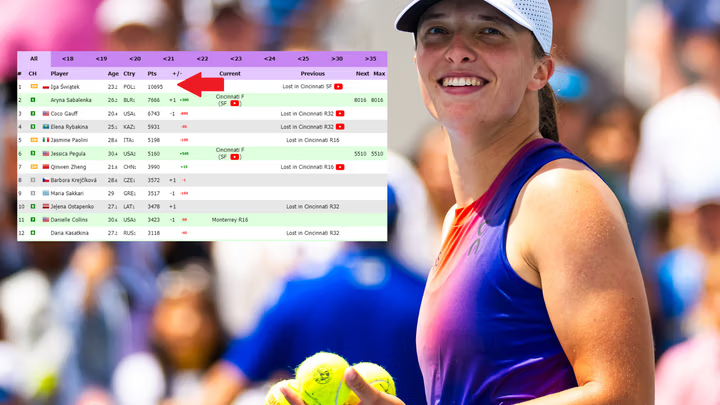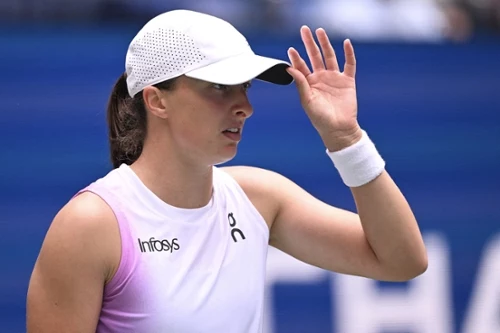The big question facing Carlos Alcaraz and Iga Swiatek after French Open titles
He played better than me – Zverev lost to Alcaraz in the French Open final
Sign up for our free sports email for all the latest news
Email
I would like to be emailed about offers, events and updates from The Independent. Read our privacy policy
Iga Swiatek called it a “huge challenge”, while Carlos Alcaraz wanted to enjoy his third grand slam title before turning his mind to emulating Rod Laver, Bjorn Borg, Rafael Nadal, Roger Federer and Novak Djokovic. On the women’s side, there is Margaret Court, Evonne Goolagong, Billie Jean King, Chris Evert, Martina Navratilova, Steffi Graf and Serena Williams. Between them, it is a list of tennis legends and all-time greats – but a select group, too. They are the only players in the Open era to win the French Open and Wimbledon in the same summer.
The Roland Garros-Wimbledon double, or the Channel Slam, as it is sometimes known, is notoriously difficult to accomplish. Only the most consummate players have mastered the switch from clay to grass after the French Open and the transition between different surfaces while being successful on both, especially for those who go deep into the tournament in Paris. It may not be as hard as it used to be, given there are now three weeks between the grand slams rather than two, as well as the changing nature of grass and how it plays, but it’s still among the toughest tests in the sport.
To win the French Open and Wimbledon back to back requires a great champion, capable of not only remarkable levels of mental and physical recovery following the clay season but with the drive and determination to set new targets once arriving onto the grass. It explains why, since the turn of the century, only Williams, Nadal, Djokovic and Federer have succeeded. But with Djokovic a major doubt for Wimbledon after undergoing knee surgery and Nadal choosing to prioritise the Olympics, that era is fast coming to a close.
However, Swiatek and Alcaraz displayed further signs during their triumphant French Open campaigns that they can carry the game forward and challenge for such records. After saving a match point in her second-round thriller against Naomi Osaka, Swiatek cruised to a third consecutive French Open title and fourth in five years. A day later, Alcaraz battled from behind to defeat Alexander Zverev in five sets, winning in Paris for the first time and adding Roland Garros to his US Open and Wimbledon titles.
For the 21-year-old Alcaraz, the transition from grass to clay is one he managed seamlessly throughout his Wimbledon run last year, having arrived at Queen’s Club in late June without ever winning a title on grass before flourishing on the surface. It was his victory in SW19 that confirmed Alcaraz as the most complete champion the sport had produced since its big three, as his historic victory in Paris proved: the Spaniard is the youngest player in tennis history to win grand slam titles on all three surfaces. He is comfortably the most rounded, all-court player tennis has produced since Djokovic, Nadal and Federer.
Taylor Swift-fan Iga Swiatek in tears after watching the idol perform on Eras Tour
Euro 2024 fixtures: Full schedule, dates and kick-off times
Those with a High Sugar Level please read it – before they delete it
Naturally, this makes Alcaraz an immediate candidate for the Roland Garros-Wimbledon double, and the new world No 2 will be considered the favourite as defending champion especially if Djokovic, the seven-time winner, is unable to compete come 1 July. Being the favourite would be a new experience but, in coming from behind to beat both the new world No 1 Jannik Sinner in the semi-finals and Zverev in the final, Alcaraz not only showed but embraced the mental fortitude and resilience to “suffer”. It is an ability required to defend a grand slam title and go deep in consecutive slams.
Swiatek and Alcaraz will face different challenges at Wimbledon
Swiatek and Alcaraz will face different challenges at Wimbledon (Getty)
Swiatek, meanwhile, will return to Wimbledon with a different approach. While her dominance on clay and hard courts is obvious – the world No 1 has now elevated herself above her peers with a fifth grand slam title at the age of just 23 – Swiatek still considers herself to be a learner on grass, although she showed marked improvement in SW19 last year and flashes of the potential to turn into a grass-court great. But as Alcaraz showed last year, entering a tournament with nothing to lose and everything to win can be dangerous for the rest of the field. Swiatek has played a demanding schedule over the clay-court season, more so than Alcaraz, but every grand slam title will fuel the belief that she can contend at Wimbledon.
He played better than me – Zverev on losing to Alcaraz in French Open final
Sign up to our free sport email for all the latest news
Email
I would like to be emailed about offers, events and updates from The Independent. Read our privacy policy
Iga Swiatek called it a “huge challenge”, while Carlos Alcaraz wanted to enjoy his third grand slam title before turning his mind to emulating Rod Laver, Bjorn Borg, Rafael Nadal, Roger Federer and Novak Djokovic. On the women’s side, there is Margaret Court, Evonne Goolagong, Billie Jean King, Chris Evert, Martina Navratilova, Steffi Graf and Serena Williams. Between them, it is a list of tennis legends and all-time greats – but a select group, too. They are the only players in the Open era to win the French Open and Wimbledon in the same summer.
The Roland Garros-Wimbledon double, or the Channel Slam, as it is sometimes known, is notoriously difficult to accomplish. Only the most consummate players have mastered the switch from clay to grass after the French Open and the transition between different surfaces while being successful on both, especially for those who go deep into the tournament in Paris. It may not be as hard as it used to be, given there are now three weeks between the grand slams rather than two, as well as the changing nature of grass and how it plays, but it’s still among the toughest tests in the sport.
To win the French Open and Wimbledon back to back requires a great champion, capable of not only remarkable levels of mental and physical recovery following the clay season but with the drive and determination to set new targets once arriving onto the grass. It explains why, since the turn of the century, only Williams, Nadal, Djokovic and Federer have succeeded. But with Djokovic a major doubt for Wimbledon after undergoing knee surgery and Nadal choosing to prioritise the Olympics, that era is fast coming to a close.
However, Swiatek and Alcaraz displayed further signs during their triumphant French Open campaigns that they have the capacity to carry the game forward and challenge for such records. After saving a match point in her second-round thriller against Naomi Osaka, Swiatek cruised to a third consecutive French Open title and fourth in five years. A day later, Alcaraz battled from behind to defeat Alexander Zverev in five sets, winning in Paris for the first time and adding Roland Garros to his US Open and Wimbledon titles.
For the 21-year-old Alcaraz, the transition from grass to clay is one he managed seamlessly throughout his Wimbledon run last year, having arrived at Queen’s Club in late June without ever winning a title on grass before flourishing on the surface. It was his victory in SW19 that confirmed Alcaraz as the most complete champion the sport had produced since its big three, as his historic victory in Paris proved: the Spaniard is the youngest player in tennis history to win grand slam titles on all three surfaces. He is comfortably the most rounded, all-court player tennis has produced since Djokovic, Nadal and Federer.
Taylor Swift-fan Iga Swiatek in tears after watching idol perform on Eras Tour
Euro 2024 fixtures: Full schedule, dates and kick-off times
Those with High Sugar Level please read it – before they delete it
Naturally, this makes Alcaraz an immediate candidate for the Roland Garros-Wimbledon double, and the new world No 2 will be considered the favourite as defending champion especially if Djokovic, the seven-time winner, is unable to compete come 1 July. Being the favourite would be a new experience but, in coming from behind to beat both the new world No 1 Jannik Sinner in the semi-finals and Zverev in the final, Alcaraz not only showed but embraced the mental fortitude and resilience to “suffer”. It is an ability required to defend a grand slam title and go deep in consecutive slams.
Swiatek and Alcaraz will face different challenges at Wimbledon
Swiatek and Alcaraz will face different challenges at Wimbledon (Getty)
Swiatek, meanwhile, will return to Wimbledon with a different approach. While her dominance on clay and hard courts is obvious – the world No 1 has now elevated herself above her peers with a fifth grand slam title at the age of just 23 – Swiatek still considers herself to be a learner on grass, although she showed marked improvement in SW19 last year and flashes of the potential to turn into a grass-court great. But as Alcaraz showed last year, entering a tournament with nothing to lose and everything to win can be dangerous for the rest of the field. Swiatek has played a demanding schedule over the clay-court season, more so than Alcaraz, but every grand slam title will fuel the belief that she can contend at Wimbledon.

